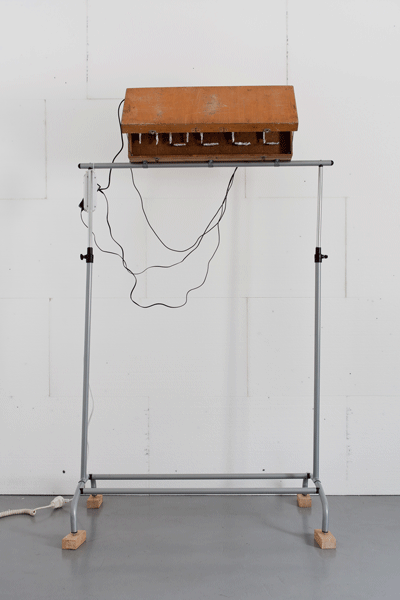Andreas Fischer
Galerie Reinhard Hauff
Galerie Reinhard Hauff

The unusual installation of Andreas Fischers first solo exhibition in Stuttgart took me by surprise. The gallerys interior was transformed into a series of rooms divided by Polystyrene walls creating intimate and sound-absorbing spaces to exhibit his kinetic sculptures. The unique acoustic property of the Polystyrene gave the space an underground-bunker feeling as did the use of temporary fluorescent lighting. Fisher transforms everyday household objects into machines by using electronic controls and simple components. The works initially look like sculptures; when viewers pass by, motion detectors unexpectedly bring them to life with various moving mechanical parts and sound tracks.
In addition to mechanics and sound, the subversive use of audio and visual puns characterises Fischers work. Maria (2010) distorts the well-known 17th-century Catholic song Maria, breit den Mantel aus (Maria, spread your protective cloak over me). A metal chair draped with a towel and fitted with two speakers, hidden in lamps attached to each chair arm suddenly starts moving and singing the song recorded by Fischer. The repetitive rocking motion combined with the melody suggests that no harm can come, once one sits underneath the cloak as long as one resists the temptation to look upwards.
In Kaiman Krücke (Caiman crutch, 2011), a tuft of hair swings back and forth over a bed-head frame to the sound of a popular sailor song Kaiman Krücke, also sung by Fischer who is referring to the relaxed life one could have living on a tropical island and earning money on the stock market without paying taxes. His bass voice provides the perfect tones for lamenting songs and also for spoken texts, which sound like old radio broadcasts. In -_Wirds bald_ (Itll be soon, 2011), the artist repeats how things will get besser (better). My doubts intensified as I observed the open laser on the CD-drive playing the mantra. It could stop at any time without improving anything.
The ten sculptures shown in the exhibition work both collectively and independently. Performing together, Fischers machines create a discordant soundtrack an orchestra of mechanical parts and music. Yet the machines follow their own logic and have a uniquely anthropomorphic sense of charm performing laborious tasks and simultaneously exploring their intentions, as if they were made out of human flesh and bone instead of the everyday objects that serve humans. However efficiently they perform their tasks, their purpose continues to be speculative, regardless of their interaction with visitors movements. The tensions that exist in Fischers kinetic sculptures reveal the constraints inherent in our relationship to machines: not only how machines operate but also how they reflect the social and political uncertainties that exist in our lives.

















